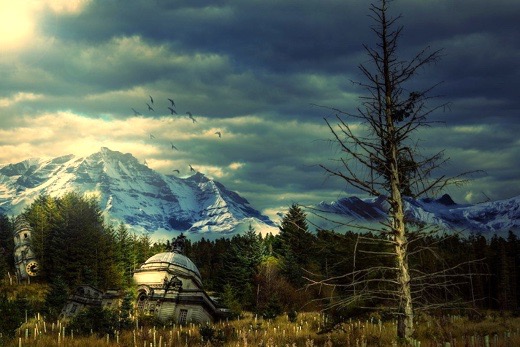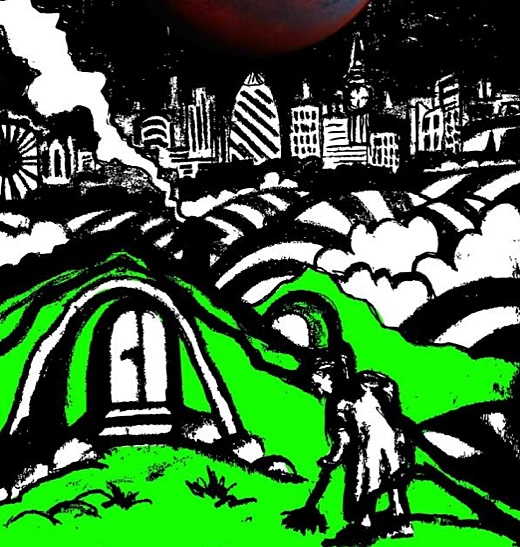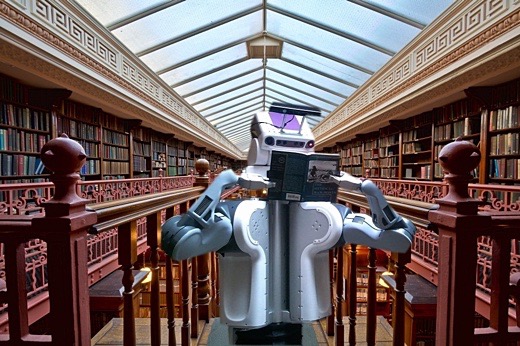SUBHEAD: It is getting clearer as to how the complex and poisonous system we are riding will fail.
By Juan Wilson on 4 March 2020 for Island Breath -
(https://islandbreath.blogspot.com/2020/03/going-down-with-books.html)

Image above: View from a full wall home library. It's a start. From (https://images.app.goo.gl/634TXyX3moM2Fcvt5).
Don't count on a last minute reprieve, a bailout, or escape from our current condition. The impending failure of the system we depend on is an on-going process has been accelerated now by a worldwide virus pandemic.
We have become blind to our total dependence on "The System" (or "The Grid") that we see no alternative reality.
As we have discovered the "System" requires massive inputs of resources ans energy and, as a result, huge outputs of waste and pollution. It also requires that we have no scalable substitutions or alternatives to this dependency but turning to total collapse.
There is simply too many of us and too much our stuff and too little of everything else. Kicking and screaming we will be dragged to the consequences.
How blind are we? Is the best we can come up with for our next president is a contest between Trump and Biden?
These are two fossils who either have no clue of the existential challenge we face or are counting on fleeing with the billionaires to the Alps or some inaccessible tropical island.
Three elements of the perfect storm we are sailing into are:
That would include skills growing food and procuring potable water; experience with building and maintaining the home; knowledge of medical care; and an idea of the principals of general science.
At some point in the not so distant future your iPhone will be about useful as a drink coaster for acquiring and storing these, instructions, and techniques in independent living.
Yes, fifty years ago young people were seriously considering getting "Off the Grid" and taking actions to get back to "The Land" and be self-sustainable. The mantra was from our guru Timothy Leary was "Tune In, Turn On and Drop Out!"
They almost made it but traded bluejeans for polyester bell-bottoms and LSD for cocaine.
It's a good idea to keep acid free paper books on the principals of all of these subjects.
Half a century ago this kind of information was widely published and identified in "The Whole Earth Catalog" and can still be found in "Back to the Land" books and other publications from the Hippy-Trippy1970's.
Fortunately, not all has been forgotten of the knowledge of the earlier Urban Hippie diaspora.
This survival knowledge can still be obtained from bookstores and online.
Having a printed book library of basic techniques is a crucial resource, just as much as a toolshed of wood working, metal working and garden implements.
Vital information can be found in publications like the US Army Survival Field Manuals and tomes with specifics on the knowledge required for basic survival, and sustained living independently of the sprawl of suburbia, office parks, malls, hospitals and supermarkets.
Many libraries offers free older hardcover books of fiction and non fiction as they are rotated off their shelves. Many libraries are still getting rid of entire sets of hardcover encyclopedias.
I recommend that you start building a library of crucial information and reference books... but also collect classic reading material for entertainment. Much is available and there won't be any Netflix, Hulu or Amazon Prime.
Author's note:
One little book (3"x 5" x 3/4") I would suggest everyone own is "Pocket Ref" by Thomas J. Glover by Sequoia Press. My version is the Third Edition (ISBN 978-1-885071-33-0). It is an encyclopedia of information showing everything from illustrations of a wide variety of rope knots and bends to a listing of all the phone area code numbers by state in North America to the friction loss in pipes of various materials, to the square, cubes, square roots, and cube root of all numbers from 1 to 1,000 to five place accuracy... plus much, much more. You'll be amazed what's in this tiny gem. I got mine at my local Ace Hardware Store.
By Juan Wilson on 4 March 2020 for Island Breath -
(https://islandbreath.blogspot.com/2020/03/going-down-with-books.html)

Image above: View from a full wall home library. It's a start. From (https://images.app.goo.gl/634TXyX3moM2Fcvt5).
Don't count on a last minute reprieve, a bailout, or escape from our current condition. The impending failure of the system we depend on is an on-going process has been accelerated now by a worldwide virus pandemic.
We have become blind to our total dependence on "The System" (or "The Grid") that we see no alternative reality.
As we have discovered the "System" requires massive inputs of resources ans energy and, as a result, huge outputs of waste and pollution. It also requires that we have no scalable substitutions or alternatives to this dependency but turning to total collapse.
There is simply too many of us and too much our stuff and too little of everything else. Kicking and screaming we will be dragged to the consequences.
How blind are we? Is the best we can come up with for our next president is a contest between Trump and Biden?
These are two fossils who either have no clue of the existential challenge we face or are counting on fleeing with the billionaires to the Alps or some inaccessible tropical island.
Three elements of the perfect storm we are sailing into are:
- Loss of individual, family, or group knowledge of fending for one's own.
- Uncontrolled debt inflation to finance industrialization and economic growth.
- Ravaging of the Earth for settlements, agland, resources, and places to toss garbage.
That would include skills growing food and procuring potable water; experience with building and maintaining the home; knowledge of medical care; and an idea of the principals of general science.
At some point in the not so distant future your iPhone will be about useful as a drink coaster for acquiring and storing these, instructions, and techniques in independent living.
Yes, fifty years ago young people were seriously considering getting "Off the Grid" and taking actions to get back to "The Land" and be self-sustainable. The mantra was from our guru Timothy Leary was "Tune In, Turn On and Drop Out!"
They almost made it but traded bluejeans for polyester bell-bottoms and LSD for cocaine.
It's a good idea to keep acid free paper books on the principals of all of these subjects.
Half a century ago this kind of information was widely published and identified in "The Whole Earth Catalog" and can still be found in "Back to the Land" books and other publications from the Hippy-Trippy1970's.
Fortunately, not all has been forgotten of the knowledge of the earlier Urban Hippie diaspora.
This survival knowledge can still be obtained from bookstores and online.
Having a printed book library of basic techniques is a crucial resource, just as much as a toolshed of wood working, metal working and garden implements.
Vital information can be found in publications like the US Army Survival Field Manuals and tomes with specifics on the knowledge required for basic survival, and sustained living independently of the sprawl of suburbia, office parks, malls, hospitals and supermarkets.
Many libraries offers free older hardcover books of fiction and non fiction as they are rotated off their shelves. Many libraries are still getting rid of entire sets of hardcover encyclopedias.
I recommend that you start building a library of crucial information and reference books... but also collect classic reading material for entertainment. Much is available and there won't be any Netflix, Hulu or Amazon Prime.
Author's note:
One little book (3"x 5" x 3/4") I would suggest everyone own is "Pocket Ref" by Thomas J. Glover by Sequoia Press. My version is the Third Edition (ISBN 978-1-885071-33-0). It is an encyclopedia of information showing everything from illustrations of a wide variety of rope knots and bends to a listing of all the phone area code numbers by state in North America to the friction loss in pipes of various materials, to the square, cubes, square roots, and cube root of all numbers from 1 to 1,000 to five place accuracy... plus much, much more. You'll be amazed what's in this tiny gem. I got mine at my local Ace Hardware Store.
.



